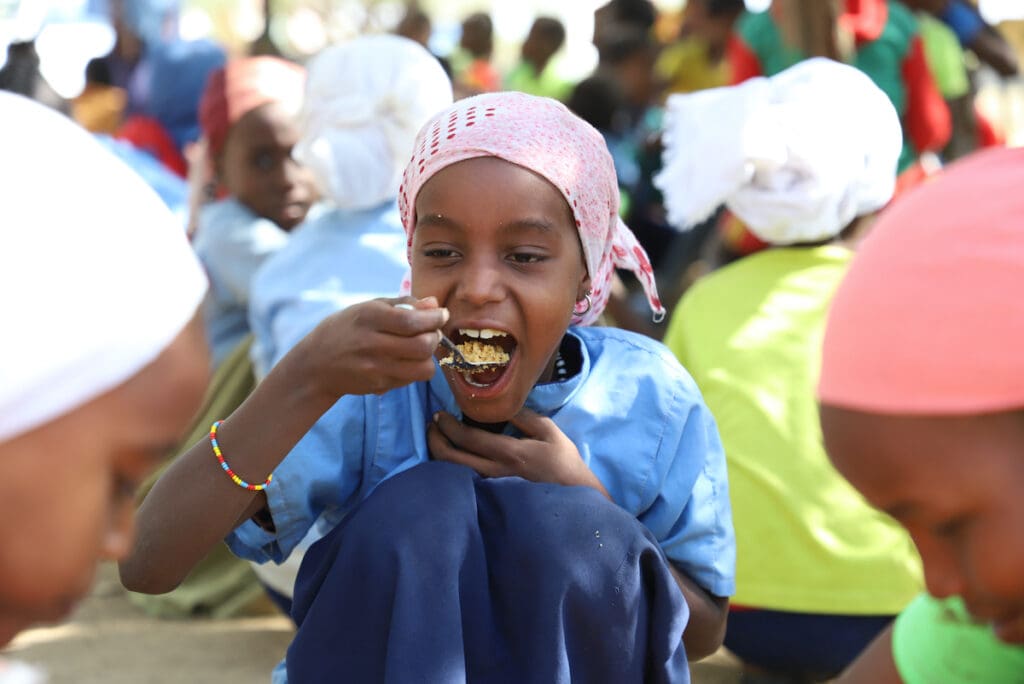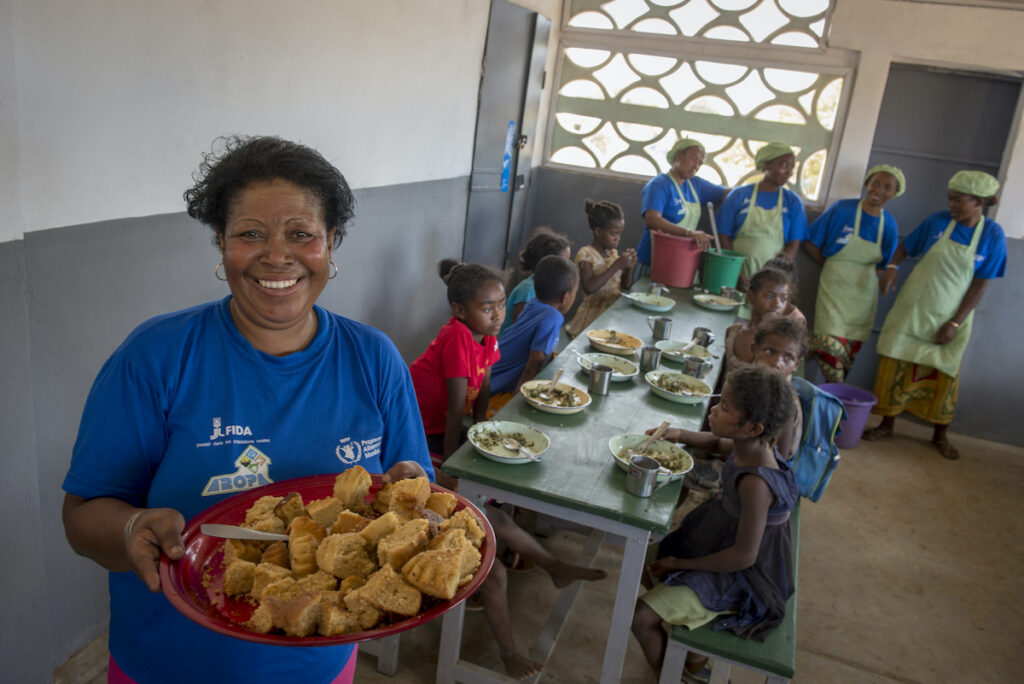This One Simple Thing Can Feed Children, Reduce Inequality, Empower Women and Girls, and Break the Cycle of Poverty

What if we could dramatically improve the nutrition of schoolchildren, keep girls in school and boost local economies with a single program? The United Nations World Food Programme’s (WFP) Home Grown School Feeding initiative is working to do just that. Our innovative approach links our school meals programs with small-scale farmers and collectives to provide millions of kids with food that’s safe, diverse, local and above all – nutritious.
Listen to this episode of our Hacking Hunger podcast here or read the story below:
If you drop into a certain school in Obock, Djibouti on a weekday, you might find around 500 students sitting on the floor of their cafeteria, happily eating their second meal of the day: Rice with sauce, peas and beets.
Many of these nutritious foods come from the U.N. World Food Programme’s Home Grown School Feeding program, through which ingredients are locally sourced and produced. That means their benefits go far beyond a simple plate of food. They involve whole communities by linking local farmers with local buyers, thereby boosting local economies.
Game Changers
“These programs are game changers for children all around the world,” says Carmen Burbano de Lara, director of the school feeding division at the UN World Food Programme’s headquarters in Rome. “If parents know that their kids are going to be fed, there is a higher chance that they send them to school.”
The meals are especially helpful for girls, who are more likely to drop out early all over the world.

A student at Gelcha Elementary School in Ethiopia enjoys a WFP school meal.
Keeping Girls in School
It’s a simple fact: our Home Grown School Feeding programs reduce inequality and empower women.
“Everywhere we implement school feeding, we see that disproportionately girls stay in school and stay in school for longer,” Burbano de Lara explains. “The longer a girl stays in school, the less likely she is to marry or have children very early in life, which gives her a better start.”
Girls who stay in school have a better chance of choosing who and when to marry, deciding if or when to have kids, and are better prepared to support their families.
“And then all of a sudden we’re breaking the cycle of poverty,” Burbano de Lara says.
Meals for the Mind
Feeding girls throughout childhood and adolescence also nourishes their minds. Take Denise, an 11-year-old student in Rwanda. She used to go to school hungry everyday because her family didn’t have enough food. Without the energy to focus, she would sit in class disengaged.
Today, Denise is a high performer.
“I leave home without eating but at school I have porridge,” she says of her school meal. “It helps me concentrate so I don’t sleep in class.”
Denise is fourth in her class now, and teachers say her energy really stands out among other students. Without the added financial pressure of providing those meals, her mother can spend the money she makes on other expenses for the family.

A cooperative worker serves cassava cake to students at the Beabo Public school in Madagascar. The vegetables grown in the garden are used to make meals for our Home Grown School Meals program.
Keeping Women in Work
Locally sourced school meals programs bolster whole communities: particularly women. Women who grow fresh fruits and vegetables have access to more income when they sell directly to schools. In countries like Ghana and Nigeria, women have formed catering companies to provide food to school kids. Even in war-torn Syria, the U.N. World Food Programme supports women-run catering companies that produce and deliver sandwiches to schools.
“These women, in many cases widows or heads of household, have the opportunity to have this job, have this income, while also helping to feed children in schools,” says Burbano de Lara.
A few years ago in Burkina Faso , a new item was added to the school feeding menu: yogurt. Nutritious, locally produced and well-liked by students, the yogurt was, and still is, produced by women’s groups.

WFP provides daily breakfast and lunch to school children in the Sahel region, giving take-home rations to girls to encourage gender equality in school attendance. School meals include fresh, locally-produced yogurt.
“Before WFP arrived, things were difficult,” explained Assiatou Hama, a member of one of the groups. “We weren’t able to sell the milk we produced, but now we manage to sell the milk easily.”
Working in their communities, feeding their families and selling their products empowers women, giving them dignity and pride.
“We will continue to design ways that we can empower women,” says Amy Blauman, the Home Grown School Feeding project manager for the U.N. World Food Programme in Rwanda.
The Future of Feeding
Blauman is excited by the impact she’s seen – on students and families, farmers and communities.
“We’re seeing strong increases in enrollment and attendance, and decreases in school dropouts. We hear stories of students who really just existed sitting in the class, hour after hour, day after day, not really engaged in what they were doing,” she says. “Then once the meal was brought in, they suddenly had energy to engage and to perform.”

WFP’s fresh and nutritious meals give families an incentive to send their children to school and keep them there, providing children with increased energy and concentration so that they are happy and ready to learn.
It’s hard to overstate the difference a meal can make: Students who were near the bottom of their class are now near the top. Teachers report drastic improvements in student performance.
“And the farmers themselves have expressed a lot of appreciation for the impact that the program has had,” Blauman says. “They’re able to organize themselves in a better way. They’re able to increase their production, their harvest, their sales, their profit margins.”
As for the future of the program?
“I would like to see all children that are living in poor families and really struggling to get an education – I would like to see all of those children getting food in schools, so that they are ready and able to learn,” says Burbano de Lara.
With your support, we’re working on doing just that.
Learn all about our school meals program here, and donate here to help us reach the children who need us most.




